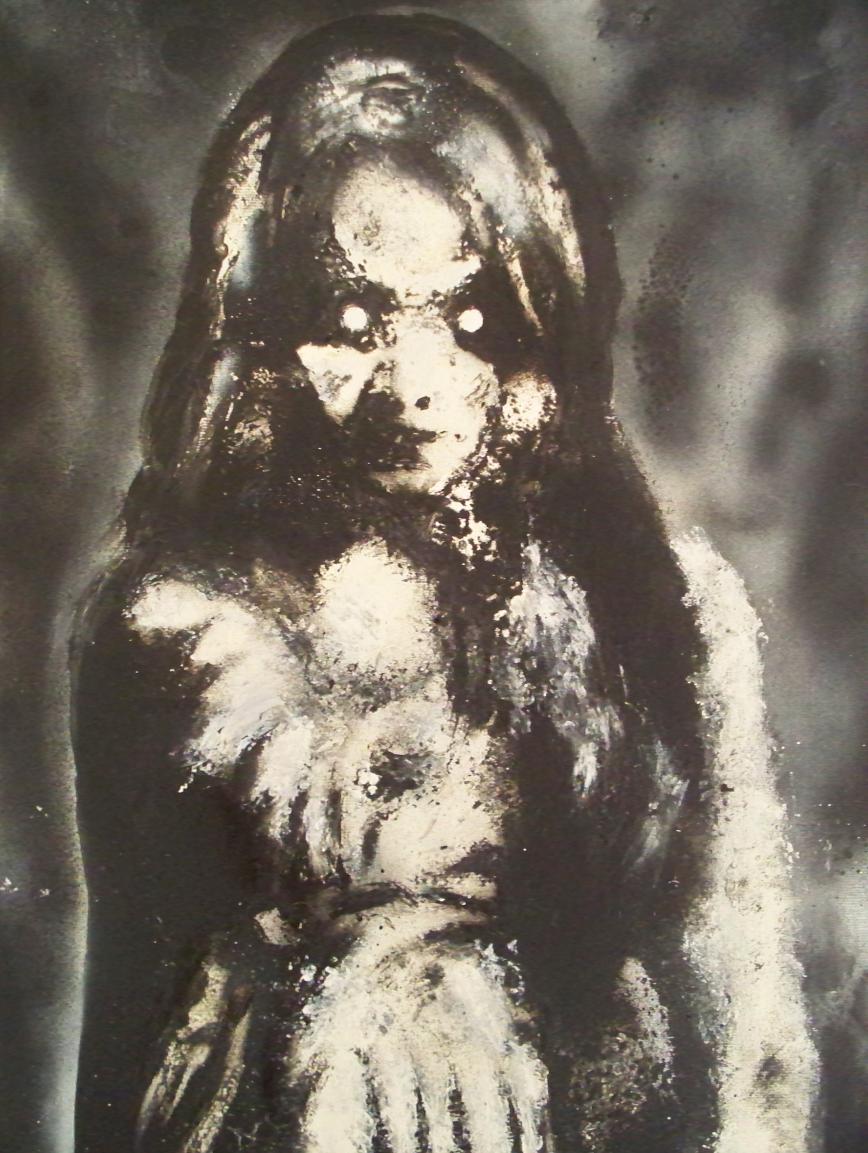Details
- 2013-07-12
- 0
- 71
- 2013
- Painting
- Aerosol Paint
- Horror
Pricing
Price and availability not indicated

- THEY WERE, THEY ARE, THEY WILL BE HERE -
Description by Mister 13
Aerosol spray and kleenex on canvas, 2 coffee, 3 cigarette. PLEASE LISTEN TO THIS SONG [link] WATCHING THE IMAGE AND READING THE TEXT FOR TO CATCH THE FEELING, IS THE 25% OF THE PIECE!!!! “The oldest and strongest emotion of mankind is fear, and the oldest and strongest kind of fear is fear of the unknown.” – H.P. Lovecraft In traditional belief and fiction, a ghost is the soul or spirit of a deceased person or animal that can appear, in visible form or other manifestation, to the living. Descriptions of the apparition of ghosts vary widely from an invisible presence to translucent or barely visible wispy shapes, to realistic, life-like visions. The deliberate attempt to contact the spirit of a deceased person is known as necromancy, or in spiritism as a séance. The belief in manifestations of the spirits of the dead is widespread, dating back to animism or ancestor worship in pre-literate cultures. Certain religious practices—funeral rites, exorcisms, and some practices of spiritualism and ritual magic—are specifically designed to appease the spirits of the dead. Ghosts are generally described as solitary essences that haunt particular locations, objects, or people they were associated with in life, though stories of phantom armies, ghost trains, phantom ships, and even ghost animals have also been recounted In many cultures malignant, restless ghosts are distinguished from the more benign spirits involved in ancestor worship. Ancestor worship typically involves rites intended to prevent revenants, vengeful spirits of the dead, imagined as starving and envious of the living. Strategies for preventing revenants may either include sacrifice: giving the dead food and drink to pacify them, or magical banishment of the deceased to force them not to return. Ritual feeding of the dead is performed in traditions like the Chinese Ghost Festival or the Western All Souls' Day. Magical banishment of the dead is present in many of the world's burial customs. The bodies found in many tumuli (kurgan) had been ritually bound before burial, and the custom of binding the dead persists, for example, in rural Anatolia. There are many references to ghosts in Mesopotamian religions - the religions of Sumer, Babylon, Assyria and other early states in Mesopotamia. Traces of these beliefs survive in the later Abrahamic religions that came to dominate the region. Ghosts were thought to be created at time of death, taking on the memory and personality of the dead person. They traveled to the netherworld, where they were assigned a position, and led an existence similar in some ways to that of the living. Relatives of the dead were expected to make offerings of food and drink to the dead to ease their conditions. If they did not, the ghosts could inflict misfortune and illness on the living. Traditional healing practices ascribed a variety of illnesses to the action of ghosts, while others were caused by gods or demons. The Hebrew Bible contains few references to ghosts, associating spiritism with forbidden occult activities cf. Deuteronomy 18:11. The most notable reference is in the First Book of Samuel (I Samuel 28:3-19 KJV), in which a disguised King Saul has the Witch of Endor summon the spirit/ghost of Samuel. There was widespread belief in ghosts in ancient Egyptian culture in the sense of the continued existence of the soul and spirit after death, with the ability to assist or harm the living, and the possibility of a second death. Over a period of more than 2,500 years, Egyptian beliefs about the nature of the afterlife evolved constantly. Many of these beliefs were recorded in inscriptions, papyrus scrolls and tomb paintings. The Egyptian Book of the Dead compiles some of the beliefs from different periods of ancient Egyptian history. By the 5th century BC, classical Greek ghosts had become haunting, frightening creatures who could work to either good or evil purposes. The spirit of the dead was believed to hover near the resting place of the corpse, and cemeteries were places the living avoided. The dead were to be ritually mourned through public ceremony, sacrifice and libations, or they might return to haunt their families. The ancient Greeks held annual feasts to honor and placate the spirits of the dead, to which the family ghosts were invited, and after which they were “firmly invited to leave until the same time next year”. Ghosts reported in medieval Europe tended to fall into two categories: the souls of the dead, or demons. The souls of the dead returned for a specific purpose. Demonic ghosts were those which existed only to torment or tempt the living. The living could tell them apart by demanding their purpose in the name of Jesus Christ. The soul of a dead person would divulge their mission, while a demonic ghost would be banished at the sound of the Holy Name. Renaissance magic took a revived interest in the occult, including necromancy. In the era of the Reformation and Counter Reformation, there was frequently a backlash against unwholesome interest in the dark arts, typified by writers such as Thomas Erastus. The Swiss Reformed pastor Ludwig Lavater supplied one of the most frequently reprinted books of the period with his Of Ghosts and Spirits Walking By Night. According to Islamic teachings, there is no such thing as Ghosts. Muslims believe that 'Ghosts' are in fact jinns. The Koran discusses spirits known as jinn. In Buddhism, there are a number of planes of existence a person into which a person can be reborn, one of which is the realm of hungry ghosts. There are many references to ghosts in Chinese culture. Even Confucius said, "Respect ghosts and gods, but keep away from them." The ghosts take many forms, depending on how the person died, and are often harmful. Many Chinese ghost beliefs have been accepted by neighboring cultures, notably Japan and south-east Asia. Ghost beliefs are closely associated with traditional Chinese religion based on ancestor worship, many of which were incorporated in Taoism. Later beliefs were influenced by Buddhism, and in turn influenced and created uniquely Chinese Buddhist beliefs. Although the human soul was sometimes symbolically or literally depicted in ancient cultures as a bird or other animal, it appears to have been widely held that the soul was an exact reproduction of the body in every feature, even down to clothing the person wore. This is depicted in artwork from various ancient cultures, including such works as the Egyptian Book of the Dead, which shows deceased people in the afterlife appearing much as they did before death, including the style of dress. A place where ghosts are reported is described as haunted, and often seen as being inhabited by spirits of deceased who may have been former residents or were familiar with the property. Supernatural activity inside homes is said to be mainly associated with violent or tragic events in the building's past such as murder, accidental death, or suicide — sometimes in the recent or ancient past. But not all hauntings are at a place of a violent death, or even on violent grounds. Many cultures and religions believe the essence of a being, such as the 'soul', continues to exist. Some philosophical and religious views argue that the 'spirits' of those who have died have not 'passed over' and are trapped inside the property where their memories and energy are strong.







